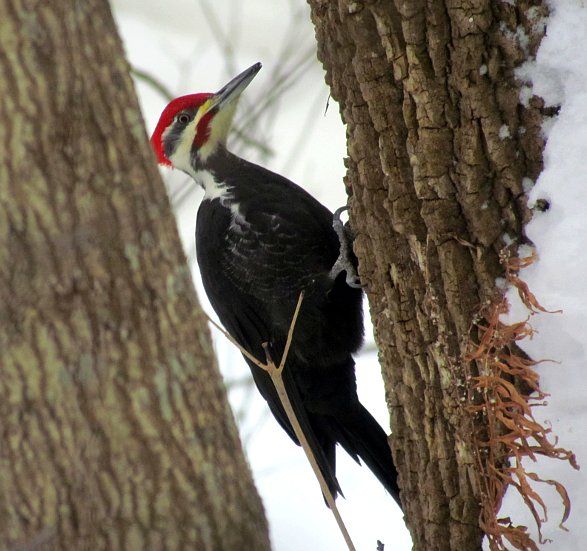Guide to Cedar Creek
Bird Life Along the Cedar Creek CorridorWarren Mead
Since we moved to our home along Cedar Creek, I have observed over 75 species of birds around our heavily wooded property. My observations range from the tiniest of species such as the ruby-throated hummingbird and kinglets, ruby-crowned and gold-crowned), to the “giants” of the local bird population—great blue herons, sandhill cranes, turkey vultures, turkeys, and even bald eagles. My list also includes birds more often seen than heard, such as the great-horned owl, barred owl, screech owl, and bobwhite.
The “bird year” along Cedar Creek begins with our winter visitors which include cardinals, blue jays, titmice, nuthatches, woodpeckers (downy, hairy, red-bellied), goldfinches (in their drab, olive-green winter plumage), mourning doves, pine siskins, purple finches, house finches and juncos, the latter commonly referred to as snow birds since they are around our area only during cold-weather months. Some less frequent winter visitors include common redpolls, tree sparrows, fox sparrows, Carolina wrens, brown creepers, flickers, red-headed woodpeckers and pileated woodpeckers.
In late winter, the tufted titmouse is the first bird to offer a hint of spring as it clearly and loudly serenades us with its “weeta-weeta-weeta” song. This uplifting sound represents the first notes of a symphony of bird song that will fill the woods for the next several months.
Spring’s next sign is the northern cardinal’s song. Usually first heard mid-to-late February, the male cardinal will sit high in a treetop and let loose with his “good cheer” song.
The first visual sign of spring along Cedar Creek (usually in mid-March) is not the robin, as many people believe, but the male red-winged blackbird, a jet-black bird with red and yellow “shoulder” stripes. Its unmistakable “kon-ker-eee” song is a sure sign of spring, since (based on my records), this is the first migratory bird to return to Cedar Creek.
When the full spring migration takes place in late April through mid-May, the woods along Cedar Creek are literally bustling with all kinds of bird life: phoebes, ruby-throated hummingbirds, Baltimore orioles, indigo buntings, rose-breasted grosbeaks, house wrens, catbirds, thrushes, vireos, summer tanagers and the full complement of warblers. Some pass through, although many of these species stay and nest along the creek. Because they tend to stay in the upper reaches of trees to feed on larvae, warblers are perhaps the most fleeting and hard to see. All kinds of warblers have landed in our backyard, usually for just a moment.
Late April through mid May is a magical time of year for a birder--you never know what bird you might see!
During the breeding and nesting season, male birds are in full, colorful breeding plumage. After they go through an early spring molt and their new feathers come in, they are in full regalia. The bird best illustrating this change is the American goldfinch. During winter, male goldfinches are a drab, mostly dusky green-to-gray. In March, they begin to molt into their breeding plumage, dramatically transforming in about six weeks to a striking yellow body with inky-black wings and a black cap.
When the nesting season is over in late summer, bird activity along the creek settles down for a while. By mid-to-late August, some of our visitors are already preparing for their southward migration. Perhaps the Baltimore oriole is the most notable departure in late August/early September. They seem to be here one day, then gone the next, leaving a void that signals the passing of another season in the bird year. The ruby-throated hummingbirds will stay around quite a bit longer—sometimes into early October. Their departure clearly signals the imminent arrival of fall.
During fall, all the winter “regulars” are active around the woods—and the bird feeders. They are establishing their winter feeding territories and preparing for harsh conditions that lie ahead. Then, usually in early November, the juncos arrive from their nesting grounds far to the north. Their appearance seems to coincide with the first snowflakes falling in the next 7-10 days.
The bird year along Cedar Creek is filled with unending activity, a constantly changing show like no other, made possible by Cedar Creek’s wild diverse habitat.
If you live near the creek, you have an enviable opportunity to see a fantastic spectrum of bird life right outside your windows. If you live elsewhere, you can see some of these birds, in season, when you walk in an
ACRES Land Trust nature preserve near Cedar Creek.
More to Explore . . .
- All About Birds. Cornell University Lab of Ornithology. https://www.allaboutbirds.org.
- Audubon Guide to North American Birds. http://www.audubon.org/bird-guide.
- The Sibley Field Guide to Birds of Eastern North America. Sibley D.A. 2003.
- The Young Birder's Guide to Birds of North America. Bill Thompson III. Houghton Mifflin Harcourt. 2012.
Birds Image Information
Carolina Wren
(Carol Roberts)
Pileated Woodpecker
(Carol Roberts)
Goldfinch
(Heather Baker)









